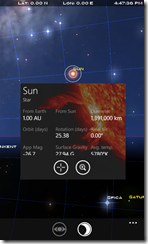Star Chart–A Definitive AR App for Windows Phone
I asked San Shepherd, co-founder of Escapist Games Ltd, a few questions about Star Chart, a high tech star gazing companion that allows you to see what’s out there in all its augmented reality glory.
Q. Tell me a bit about your background and Escapist Games.
"Our vision was to make the heavens... something that is accessible to everyone"
Chris (fellow-founder of Escapist Games) and I are ex Criterion Games. We decided we wanted to get out and start working on direct to consumer digital marketplaces. We started out with Xbox Live indie titles and progressed to looking at mobile platforms. We found that while we could produce great quality on Xbox Live, we just weren’t seeing the sales we needed to move the company forward.
We drifted towards iOS and started playing with AR (augmented reality). We then created Star Chart in XNA in about a month and ported that to the iOS eventually launching it both as an iPhone app and an Xbox Live indie game. Then we sort of forgot about it for a while and focused on other projects.
"74% of people who downloaded the trial went on to purchase the application"
We started to notice something interesting about Star Chart in its Xbox Live incarnation. It had an amazing conversion rate; 74% of people who downloaded the trial went on to purchase the application. Although we did get off to a very slow start, the iPhone version really took off over the summer, presumably due to the weather being better suited for star-gazing!
We’ve just hired our 9th employee and have apps published on Windows Phone, iOS and Android as well as being in the Ovi Store. We’re really pleased with our sales. We’re expecting to break 1.5M downloads by the end of the year. In fact the success of Star Chart worldwide has been a little bit overwhelming. We knew it was cool and interesting but we didn’t know whether that was down to our geeky tendencies or whether it would have a broader appeal. It seems to have a very broad appeal.
Q. And what about the Star Chart application?
"We’d set aside 2 weeks to do this on Windows Phone ...the developer working on it had it up and running by lunchtime"
I describe it as a high-tech star gazing companion. It’s an AR astronomy app that allows you to see what’s out there without any knowledge of astronomy. We’re not astronomers though we’re interested in the stars and planets. Our vision was to make the heavens, which are often considered overwhelmingly awe-inspiring, something that is accessible to everyone. It’s like having a knowledgeable friend in your pocket. Just hold it up to the sky and it tells you what you’re looking at, be it a star or a planet.
It’s funny because it’s not the business model we started out with – games. Instead we’ve created an educational application. It’s something we use a lot ourselves and it’s a beautiful educational application. It has a lot in common with a great game – we really focus on the visuals. We want to build something that people will love.
We have something like 127,000 stars in our database as well as planets and we’re adding a time-warp feature that allows you to see how the planets move over time. We’re also adding a 3D planets feature that will allow you to “fly away” from earth and travel to other planets, see the rings of Saturn and the swirling mists around Jupiter for example. Star Chart will just get richer and richer over time.
Q. What Mango features did you take advantage of?
We took advantage of the ability to combine an XNA drawing surface with Silverlight controls to make it easier to render our UI. And our AR implementation was based on the Motion API which gave us a very high quality experience in a very short space of time.
Q. Did anything surprise you about the Windows Phone implementation?
"Windows Phone has shown us just how good AR can be"
A few things, yes. Overall Windows Phone has shown us just how good AR can be. Before Windows Phone, iOS was the best AR platform we had but it still suffered from a slight lag and some jitter. On Windows Phone we suddenly saw those weren’t an issue. It made us realize that we weren’t hitting the limitations of AR at all. It made us go back and re-visit our implementation on other platforms to try and tune it to match the quality we were seeing on Windows Phone.
The Windows Phone SDK was a revelation. It made us so much more productive we could devote much more time to adding polish to the app. The fundamentals were already there. As an example we used the Motion API for our AR implementation. We’d set aside 2 weeks to do this on Windows Phone and the developer working on it had it up and running by lunchtime. The maturity of the SDK meant it was easier to achieve what we needed to. And in some areas, such as AR, the results were simply remarkable.
In terms of challenges, we faced some constraints around the lack of certain types of shader and limitations on colour depth. We’re still working on optimizing some of these things so we can make the app even better on the Windows Phone platform.
Overall though, the Windows Phone SDK simply allowed us to focus on making the application as good as it could be – it “got out of the way” and let us focus on building the application we wanted.
More Information
For more information on Windows Phone development, visit AppHub or download the SDK.







